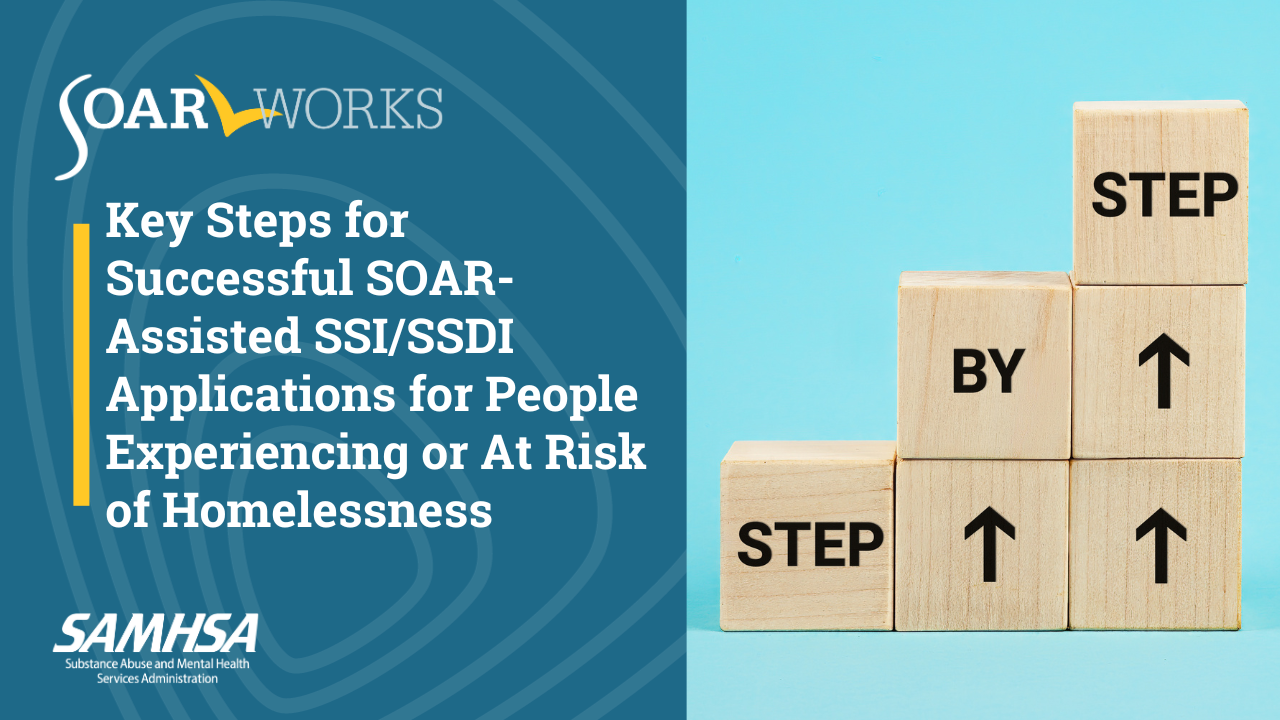If you’re assisting eligible people in applying for Supplemental Security Income (SSI) or Social Security Disability Insurance (SSDI) through the Social Security Administration (SSA), the SOAR (SSI/SSDI Outreach, Access, and Recovery) model can be a game-changer. The SOAR model is designed to increase access to disability income benefits for people who are experiencing or at risk of homelessness and have a disabling serious mental illness, co-occurring substance use disorder, and/or other medical condition.
Here are key tips for completing high-quality SSI/SSDI applications using the SOAR model highlighted in the SOAR webinar “Understanding the Steps to Completing SOAR-Assisted SSI/SSDI Applications.”
1. Understand the SOAR Model
SOAR is not a different application type but a method to streamline the SSI/SSDI application process. It increases the chances of success.
2. Start with Quality Engagement
Building a strong, trusting relationship with the applicant is the foundation to a successful application. Empathy and compassion are crucial for successful engagement.
3. Gather Comprehensive Medical Evidence
The Medical Summary Report is vital. Ensure you have all necessary medical records, both physical and mental health, to support the application.
4. Complete the Application Packet
Use up-to-date versions of essential forms like SSA-8000, SSA-1696, and SSA-3368. Thoroughly fill out these forms to represent the applicant effectively.
5. Provide Detailed Functional Information
Describe the applicant’s functional impairments and how they impact daily life. Be specific about limitations for a comprehensive view.
6. Establish a Strong Narrative
Use a narrative format to tell the applicant’s story. Explain the onset of disability and its impact on their life.
7. Develop a Residual Functional Capacity Analysis
Create a Residual Functional Capacity analysis to outline the applicant’s physical and mental limitations. It complements the medical summary report and offers a comprehensive picture.
8. Build Strong Relationships with Local Social Security Offices
Establish a connection with your local Social Security office. Reach out to contacts, and maintain open communication.
9. Overcome the Hesitancy of Medical Providers
Ensure medical providers understand the purpose of the Medical Summary Report. It’s not a disability determination but an agreement on functional impairments based on existing records.
10. Follow Up and Be Patient
After submitting the application, anticipate a wait time of about 4 to 5 months for a decision. Keep in regular contact with Social Security offices and Disability Determination Services.
11. Use Remote Engagement When Necessary
Consider remote application assistance when the applicant is not nearby. Use methods like phone interviews and video conferencing and consult your SOAR TA Center liaison for guidance.
12. Track Your Outcomes
Use the SOAR Online Application Tracking (OAT) program to track the outcomes of your SOAR-assisted SSI/SSDI applications.
13. Seek Funding and Sustainability
Agencies and organizations looking to incorporate the SOAR model can explore various avenues for funding and sustainability. Review the resources available on the SOARWorks website for guidance.
14. Stay Informed and Connected
Keep yourself updated on changes to SOAR practices and Social Security regulations. Join the SOAR email list to receive news, resources, and registration links for informative webinars and events.
By following these steps and utilizing available resources, you can successfully submit high-quality, complete SSI/SSDI applications using the SOAR model, improving the lives of those with disabilities. Want to learn more? Watch the full webinar!
This blog post was developed with the assistance of generative artificial intelligence.


